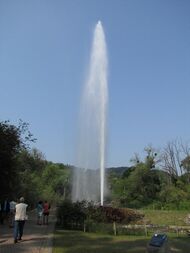Earth:Cold-water geyser
Cold-water geysers are geysers that have eruptions whose water spurts are propelled by CO
2-bubbles, instead of the hot steam which drives the more familiar hot-water geysers: The gush of a cold-water geyser is identical to the spurt from a freshly-opened bottle of soda pop.
Cold-water geysers look quite similar to their steam-driven counterparts; however, their CO
2-laden water often appears whiter and more frothy.[1]
Mechanism
In cold-water geysers, the supply of CO
2-laden water lies confined in an aquifer, in which water and CO
2 are trapped by less permeable overlying strata. The more familiar hot-water geysers derive the energy for their eruptons from the proximity to (relatively) near-surface magma. In contrast, whereas cold water geysers might also derive their supply of CO
2 from magmatic sources, by definition of "cold-water", they do not also obtain sufficient heat to provide steam pressure, and their eruptions are propelled only by the pressure of dissolved CO
2. The magnitude and frequency of such eruptions depend on various factors such as plumbing depth, CO
2 concentrations and refresh rate, aquifer water yield, etc.
The water and its load of CO
2 powering a cold-water geyser can escape the rock strata overlying its aquifer only through weak segments of rock, like faults, joints, or drilled wells. A borehole drilled for a well, for example, can unexpectedly provide an escape route for the pressurized water and CO
2 to reach the surface.
The column of water rising through the rock exerts enough pressure on the gaseous CO
2 so that it remains in the water as dissolved gas or small bubbles. When the pressure decreases due to the widening of a fissure, the CO
2 bubbles expand, and that expansion displaces the water above and causes the eruption.
Examples
File:Wallenborn-brubbel.ogv Notable cold-water geysers include:
Other cold-water geysers include:
- Caxambu, Brazil[3]
- Herľany, Slovakia
- Sivá Brada, Slovakia
- Wallender Born (a.k.a. Brubbel), Germany
- Wehr Geyser Germany
- Andernach Geyser (a.k.a. Namedyer Sprudel), Germany
References
- ↑ 1.0 1.1 "Carbon dioxide-driven, cold water geysers". University of California, Santa Barbara. 6 May 2005. http://www.uweb.ucsb.edu/~glennon/crystalgeyser/index.htm.
- ↑ "The operation and geography of carbon-dioxide-driven, cold-water geysers". GOSA Transactions 9: 184–192. 2005.
- ↑ Bonotto, Daniel Marcos (2016). "Hydrogeochemical study of spas groundwaters from southeast Brazil". Journal of Geochemical Exploration 169: 60–72. doi:10.1016/j.gexplo.2016.07.016.
 |


